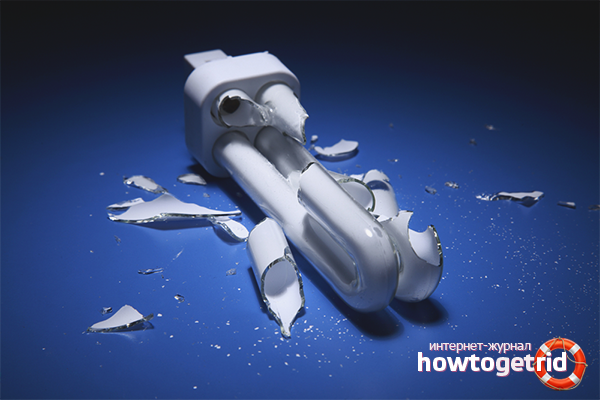The content of the article
Classic incandescent bulbs are supplanted by more modern fluorescent varieties. Energy saving options use less electricity, so the cost of their purchase pays off after 3-6 months after the purchase. Fluorescent lamps are convenient, compact, but have one major drawback, because of which the burnt product cannot be thrown into the ordinary trash can.
Dangerous filler
Consumers should be aware that every energy-saving product purchased in the store is guaranteed.If the lamp lasts less than 6–12 months, it can be exchanged for a new one. The seller must present a receipt and a box with the date of production. Did the lamp work properly and burn out? We'll have to look for companies involved in the disposal of such waste.
Why not throw the lamp along with the rest of the garbage? Fragile glass may break when struck, and then mercury vapor will begin to seep into the ground and soar in the air. People, including the owners, who will walk next to the house, will have to breathe dangerous substance. Mercury poisons the human body: the work of the digestive organs and the respiratory system is disturbed, the kidneys and the heart are affected. A few broken lamps are enough to get into the hospital with severe intoxication. Children and animals are more sensitive to mercury vapor, and 1-2 mg of a substance is enough to get poisoned.
Where to go
Energy-saving lighting devices should be put in a separate garbage bag, or better in a hermetic package, and make sure that they do not break. With waste, the owner of the apartment goes to the nearest REU or DEZ, who is obliged to accept the lamp for free and without objection.The alternative is the local housing office management, which should have special cardboard boxes for storing and transporting fluorescent devices. They are sorted by size and height, placed in separate cells, and then sent to factories engaged in the neutralization and processing of mercury waste.
If stubborn bureaucrats refuse to fulfill their direct responsibilities, they should be reminded of the disposal of the government at number 949-РП signed in May 2010. In accordance with the law on the transportation and disposal of used lamps, individuals can donate energy-saving varieties to the REU free of charge, but, in truth, in small quantities.
What companies and firms do
Owners of enterprises and offices can not use the services of the ECD. They must independently conclude an agreement with factories or firms that will pick up used lamps and take them to special places. You can find the address and contact details of the nearest receiving point on the Greenpeace website, where you can also welcome to poor performance and improper disposal of mercury-containinglighting fixtures.
Companies working directly with the supplier may enter into a special agreement. For a fee, the company will pick up products that have expired or burned out.
Lamp crashed: emergency measures
If the glass bulb of the energy-saving lamp is damaged, it is necessary to drive the pets out of the room and take the children away. Close the door or curtains so that mercury does not spread throughout the house. Open the window for at least 20 minutes to weather dangerous vapor fumes.
Work with the remnants of the lamp should be one person. Wear rubber gloves and a gauze bandage, a damp cloth will do. Armed with two pieces of cardboard: one instead of a dustpan, the second rake glass fragments. The remains of the broken lamp pour in a sealed package or a jar of water, put in the trash bag.
Wipe the floors in the room with a solution of potassium permanganate or sprinkle with bleach. To include the remains of an energy-saving lamp in the ECD. If there is no such organization, you can call the Ministry of Emergency Situations and find out how to deal with a broken fluorescent lamp.
Energy-saving devices are not as dangerous as thermometers, so you should not worry.Enough airing and mopping the floor. If the pieces of the lamp hit the carpet, it should be taken out onto the street and knocked out from the wrong side. Leave for a few hours or a day in the open air.
A broken glass flask must not be buried in the ground or thrown into trash containers. Houses do not recommend storage either. Residents of large cities can call a special team that will remove the remains of an energy-saving lamp, check the concentration of mercury in the air, and determine whether a carpet or a sofa, next to which a fluorescent device has broken, is dangerous for apartment owners.
Recycling features
In small towns and villages, either people themselves or volunteers are engaged in the disposal of fluorescent lighting devices.Sometimes neighbors can cooperate, collect a certain number of lamps and take them to a regional center.
Some office workers bring used energy-saving appliances to work and rent to the company. Ask your electrician or manual about this disposal option. Consciousness of citizens is sometimes not only approved, but also encouraged.
Disposal of fluorescent lamps - a difficult and troublesome, so most people prefer not to bother. But each lighting device, emitted in accordance with the rules, not only saves the environment, but also protects the owner from an administrative fine.
Video: how to properly dispose of energy-saving light bulbs












To send